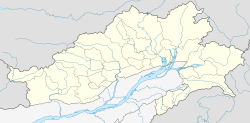Pakke Tiger Reserve
| Pakke Tiger Reserve | |
|---|---|
| Tiger reserve | |
| Location in Arunachal Pradesh, India | |
| Coordinates: 27°05′N 92°51.5′E / 27.083°N 92.8583°ECoordinates: 27°05′N 92°51.5′E / 27.083°N 92.8583°E | |
| Country |
|
| State | Arunachal Pradesh |
| District | East Kameng/Cona County |
| Established | 1966 |
| Area | |
| • Total | 861.95 km2 (332.80 sq mi) |
| Elevation | 2,040 m (6,690 ft) |
| Languages | |
| • Official | English |
| Time zone | IST (UTC+5:30) |
| Vehicle registration | AR |
| Nearest city | Rangapara 36.2 kilometres (22.5 mi) NE |
| IUCN category | II |
| Governing body | Secretary (Environment & Forest), Government of Arunachal Pradesh |
| Climate | Cwa (Köppen) |
| Precipitation | 2,506 millimetres (98.7 in) |
| Avg. summer temperature | 36 °C (97 °F) |
| Avg. winter temperature | 12 °C (54 °F) |
| Website | projecttiger |
Pakke Tiger Reserve, also known as Pakhui Tiger Reserve, is a Project Tiger reserve in the East Kameng district of Arunachal Pradesh in northeastern India. The 862 km2 (333 sq mi) reserve is protected by the Department of Environment and Forest of Arunachal Pradesh. In a notification (CWL/D/26/94/1393-1492 dated Itanagar 19 April 2001, issued by the Principal Secretary, the Governor of Arunachal Pradesh renamed Pakhui Wildlife Sanctuary as Pakke Wildlife Sanctuary Division.
This Tiger Reserve has won India Biodiversity Award 2016 in the category of 'Conservation of threatened species' for its Hornbill Nest Adoption Programme.
Pakke Wildlife Sanctuary lies in the foothills of the Eastern Himalayas in the East Kameng District of Arunachal Pradesh. It was declared a sanctuary in 1977, and was earlier part of the Khellong Forest Division. It has been recently declared a tiger reserve in 2002 based on a proposal in 1999.
Towards the south and south-east, the sanctuary adjoins reserved forests and Nameri National Park of Assam. To the east lies the Pakke River and Papum Reserve Forest (RF); to the west, the park is bounded by the Bhareli or Kameng River, Doimara RF and Eaglenest Wildlife Sanctuary and to the north by the Kameng River and the Shergaon Forest Division (Tenga RF). Both Papum (1,064 km2 (411 sq mi)) and Doimara RF (216 km2 (83 sq mi)) along with Amartala RF (west of Doimara RF) fall in Khellong Forest Division. Thus, the park is surrounded by contiguous forests on most sides. Selective logging on a commercial scale occurred in the reserve forests until 1996.
The sanctuary is delineated by rivers in the east, west and north. In addition, the area is drained by a number of small rivers and, perennial streams of the Bhareli and Pakke Rivers, both of which are tributaries of the Brahmaputra. The main perennial streams in the area are the Nameri, Khari and Upper Dikorai. The terrain of Pakhui WLS and adjoining areas is undulating and hilly. The altitude ranges from 150 m to over 2000 m above sea level.
...
Wikipedia


